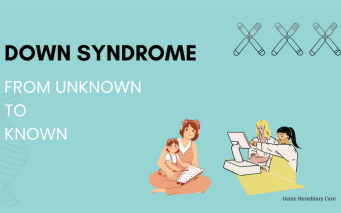
KABUKI SYNDROME
Origin and history of the disorder
Niikawa and Kuroki (1981) reported a case of long palpebral fissures, prominent ears, and high-arched eyebrows with an intellectual disability. Since these features resemble the mask used in the Japanese kabuki theater play, this disorder was named the kabuki syndrome.
Incidence and prevalence
Initially, the incidence seemed to be 1 in 32,000 Japanese individuals; however, many cases have been reported in other countries, such as North America, Asia, Europe, and Taiwan.
Genotypes of Kabuki syndrome
- KMT2D (Lysine methyltransferase 2D) also named as MLL2 gene located in chromosome 12q13.12
- KDM6A (Demethylase 6A) located in X-Chromosome
In addition to the genes involved in the methylation and demethylation of histones, other microdeletions, and duplications have also been reported as causative genomic patterns in Kabuki syndrome.
Microdeletion in 22q11.2, with common kabuki syndrome phenotypes presented with congenital heart disease, may overlap with Di-George syndrome, as microdeletion in 22q11.2 is the characteristic cause of this syndrome with congenital heart disease and interstitial duplication in chromosome 1 at p13.1 to p22.1, presenting with microcephaly and epicanthal folds in addition to other kabuki phenotypes.
In addition to mutations in KMT2D or KDM6A (single gene), microdeletions and duplications, mosaic Turner Syndrome, especially with ring X-chromosome, have also been reported with Kabuki syndrome phenotypes, in addition to delayed puberty and short stature.
Inheritance
Mutations in KMT2D and KDM6A follow an autosomal dominant and X-linked pattern of inheritance, respectively. Most cases seem sporadic.
One case has been reported of paternal inheritance of this syndrome with congenital dislocation of the hip and short stature that seems to be present in both siblings, as in their father.
Type of mutation:
Most kabuki syndrome cases proven with whole exome sequencing show that nonsense mutations in the KMT2D gene lead to truncation of the methylase protein, thus leading to loss of function of this gene due to nonsense-mediated mRNA decay.
Frameshift and missense mutations lead to the loss of a few amino acids, and one or two amino acids are replaced by another, respectively, resulting in methylase protein dysfunction.
Phenotypes:
The phenotypes listed below appear to be the typical characteristics of this syndrome.
- Long palpebral fissures
- Prominent ears
- Depressed nasal tip
- Short columella
- Fetal fingertip pads
- Eversion of lower eyelids
- Long eyelashes
- Arched eyebrows
- Intellectual disability
- Postnatal growth retardation
In addition to these phenotypes, the following have been reported in various cases worldwide.
- Brachydactyly
- microcephaly
- Clinodactyly of the 5th digit in the hand
- Joint dislocations, hypermobility
- Coloboma
- Ptosis
- Epicanthal folds
- Strabismus
- Widely spaced teeth, Microdontia
- Micrognathia
- Malocclusion
- High-arched palate
- Cleft lip and palate
- Short stature
Genetic Diagnosis & Genetic Counseling
- Since two genes (KMT2D/ MLL2 and KDM6A) seem to be the most characteristic causative genes for Kabuki syndrome, Clinical Exome sequencing (CES) seems to be the most reliable genetic test. Hence, genetic counselors may suggest CES if the patient presents with the phenotypes mentioned above and systemic involvement.
- As a few cases have been reported with microdeletions and duplications, a genetic counselor may also suggest a chromosomal microarray analysis (CMA) if CES does not answer.
- A genetic counselor refers the patient to a medical specialty to evaluate the respective systemic anomalies for early medical management.
- A genetic counselor counsels the patient regarding the genetic test, its cost, and reliability, along with its limitations, and leaves the decision to the patient and their family.
- During a post-test genetic counseling session, a genetic counselor explains the genetic test results, especially the possible medical management for Kabuki syndrome, and the possibility of inheritance of this syndrome to the next pregnancy based on inheritance in the proband (affected child).
- In the case of X-linked inheritance, a genetic counselor may not disclose the pattern of inheritance of kabuki syndrome, as it has an impact on Indian families and will also cause guilt in the parents.
- In general, the mode of inheritance from either the father or mother need not be discussed by the genetic counselor to the patient and their family during pre-test and post-test genetic counseling sessions to avoid guilt among the parents and their families.
SUMMARY
- Distinct facial features and intellectual disability characterize Kabuki syndrome.
- Its incidence is estimated to be 1 in 32,000 patients in Japan, with cases worldwide.
- Mutations in KMT2D and KDM6A were the primary genetic causes.
- Microdeletions, duplications, and Mosaic Turner Syndrome are also associated with Kabuki syndrome.
- Typical phenotypes include long palpebral fissures, prominent ears, and intellectual disability.
- Infantile presentations include dysmorphic features, hypotonia, feeding difficulties, and growth retardation.
- Systemic involvement may affect hearing, neurology, heart, endocrine, renal, and dental systems.


0 Comments